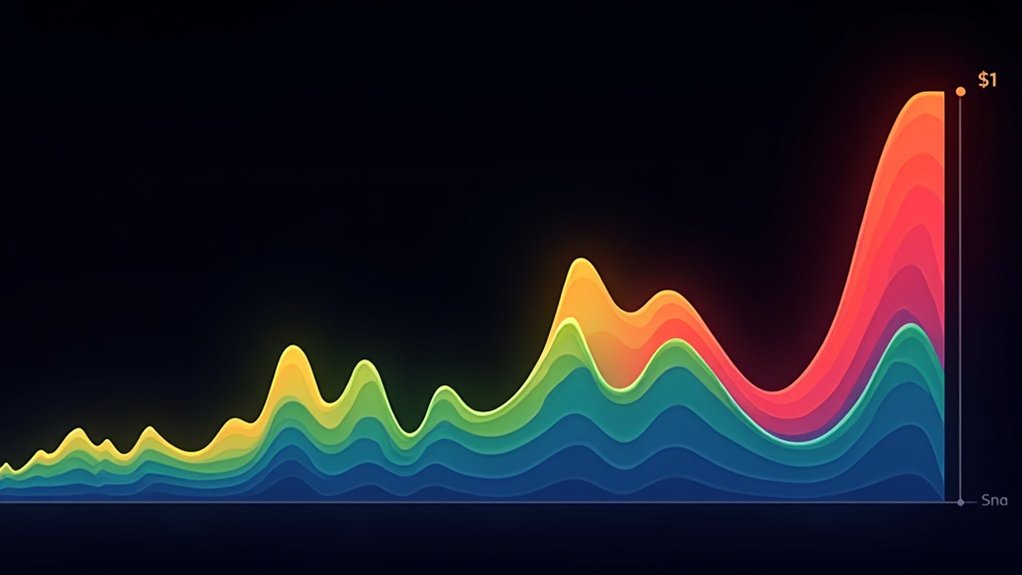The BTC volume indicator measures how much Bitcoin changes hands in a given timeframe. It’s pretty simple. High volume means active trading; low volume shows stagnation. Smart traders use it to confirm if price movements are legit or fake news. Volume spikes often signal trend exhaustion points, while rising prices with increasing volume indicate strong momentum. It’s just one piece of the puzzle, though. The real magic happens when you pair it with other indicators.
Trading noise. That’s what Bitcoin markets are full of. But volume cuts through it. The BTC volume indicator represents the total amount of Bitcoin changing hands in a given timeframe. Simple concept, powerful tool. It shows exactly how many coins were bought and sold, giving traders a window into market activity. High volume means lots of action. Low volume? Market’s taking a nap.
Volume isn’t just some useless number. It confirms whether price movements are legit or just market mirages. When Bitcoin’s price shoots up with heavy volume backing it, that’s usually a real trend. Price climbing on pathetic volume? Probably won’t last. Smart traders watch this stuff. Just as market cap calculations help assess a cryptocurrency’s total value, volume provides crucial insights into trading activity.
Volume separates genuine Bitcoin moves from fleeting illusions. High-volume rallies have staying power. Low-volume pumps? Just smoke and mirrors.
Bitcoin traders use several volume-based indicators. On-Balance Volume (OBV) adds up volume on up days and subtracts it on down days. Chaikin Oscillator combines price and volume data to spot buying pressure. Then there’s Money Flow Index (MFI), basically a volume-weighted RSI that shows when Bitcoin might be overbought or oversold. Each serves a different purpose.
The relationship between volume and momentum is critical. Rising prices with increasing volume? Strong upward momentum. Volume drying up while price climbs? Warning sign. And those volume spikes? They often mark exhaustion points where trends change direction. Volume doesn’t lie. Traders also analyze Volume Profile to see trading activity concentrated at specific price levels rather than just over time.
In practice, traders use volume to validate what they’re seeing on price charts. Is that breakout real or fake? Volume knows. Is selling pressure easing? Check the volume. Some traders look for accumulation phases—periods of steady volume without price movement that often precede major moves. Higher volume generally indicates greater liquidity in Bitcoin markets, making it easier to execute large trades without significant price impact.
Nothing’s perfect though. Exchanges sometimes report inflated numbers. Wash trading exists. Volume from one exchange tells an incomplete story. And volume alone can’t predict which way the price will move next.
The bottom line: volume is essential, but it’s just one piece of the puzzle. Use it alongside price action. Context matters. Numbers without meaning are just noise.
Frequently Asked Questions
Can Volume Indicators Predict Bitcoin Price Reversals?
Volume indicators can indeed predict Bitcoin price reversals, but they’re not crystal balls.
Rising volume confirms trends while declining volume during price increases often signals weakening momentum.
OBV divergences are particularly telling. When prices make new highs but volume doesn’t follow? Red flag.
The most reliable signals come when multiple volume indicators align.
Still, they’re just one tool. Markets are complex beasts. Nothing works in isolation.
How Accurate Are BTC Volume Indicators During Market Volatility?
BTC volume indicators lose accuracy during volatility.
They’re surprisingly unreliable in bullish phases, showing almost zero correlation with price movements.
Bear markets? Different story. Volume actually tracks volatility decently then (+0.39 correlation).
The indicators struggle most in choppy, directionless markets. No clear trend means volume signals get muddied. Fast.
Volume changes affect downtrends quicker (88% speed) than uptrends.
But overall? Volume’s predictive power remains weak during volatile periods.
Not exactly crystal ball material.
What Timeframes Work Best for Bitcoin Volume Analysis?
Bitcoin volume analysis works across multiple timeframes, each serving different purposes.
Day traders favor 5-15 minute charts for immediate signals. Swing traders rely on 1-hour and 4-hour frames to identify broader trends with less noise. Long-term investors stick to daily and weekly charts for major support/resistance zones.
Volume tends to peak around 10-11 AM EST. Smart traders combine timeframes—higher ones for trend direction, lower ones for precise entries.
No perfect timeframe exists. Market context matters most.
Do Exchange-Specific Volume Data Affect Indicator Reliability?
Yes, exchange-specific volume data greatly impacts indicator reliability. Different exchanges report wildly varying figures—some outright misleading.
Low-liquidity platforms? Erratic data, period. When an exchange shows anomalous volume spikes, indicators like OBV or Chaikin can generate false signals.
Smart traders use aggregated data from multiple reputable exchanges. Single-exchange volume is like listening to one person in a crowd.
Local market conditions at individual exchanges don’t reflect global Bitcoin supply-demand reality. Volume indicators need consistent data to work properly.
Can Volume Indicators Identify Market Manipulation in Bitcoin Trading?
Volume indicators can definitely spot market manipulation in Bitcoin trading. They reveal suspicious patterns like price movements without corresponding volume, wash trading, and artificial spikes during low-liquidity periods.
Tools like OBV and MFI expose accumulation or distribution phases manipulators exploit. But they’re not foolproof. Sophisticated traders create false volume signals all the time.
Exchanges inflate volume through wash trading. Volume data alone? Not enough. You need price action and order book analysis too.









